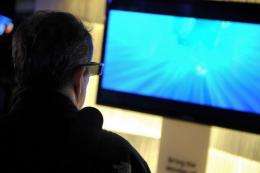Japanese group gives health tips to 3D viewers

A group of Japanese businesses has released a handbook advising viewers on health and safety when watching three-dimensional televisions to counter symptoms such as dizziness, nausea, and eye fatigue.
"There are basic rules to know" when watching 3D images safely, the consortium -- which includes Hitachi, Toshiba, Sharp, as well as government bodies -- said in its guidebook.
Different perspectives offered by each eye's line of sight enables the brain to process depth perception and therefore see images in three dimensions.
Television sets showing 3D images exploit this process by showing a slightly different image to each eye through a filter system operated by special glasses, which alternately shutter each eye's line of sight.
Electronics companies are rushing to bring 3D televisions to market with competition in the sector intensifying ahead of the summer.
Sharp plans to unveil 3D versions of its Aquos model in May, joining rivals Samsung Electronics and Sony Corp in a space the industry hopes will revive profits amid a reevaluation of the liquid crystal display business.
The guide advises audiences to respect the viewing distance, generally three times the height of the screen, adding that viewers should refrain from watching if they feel they are unable to see 3D images after prolonged viewing.
"If even in that case and after having verified any technical problems, the viewer doesn't see any depth perception and that he sees superimposed images, then he should stop," the handbook says.
It also urges viewers to stop watching if they start feeling sick or tired, saying that "perception varies greatly among people for various reasons."
Parents also need to be informed of risks when infants are involved.
"It is desirable that adults judge whether 3D televisions are suitable for their children," the group said.
It also requests makers of 3D televisions to take various preventative measures against potentially harmful symptoms affecting unaware viewers, such as unsynchronised shutters on glasses.
(c) 2010 AFP




















